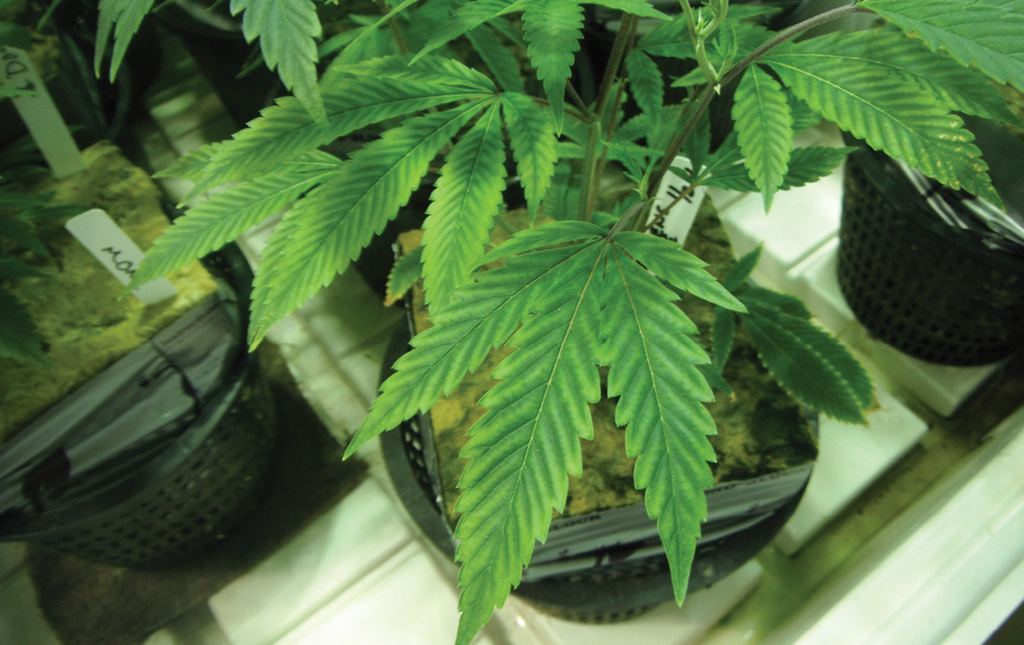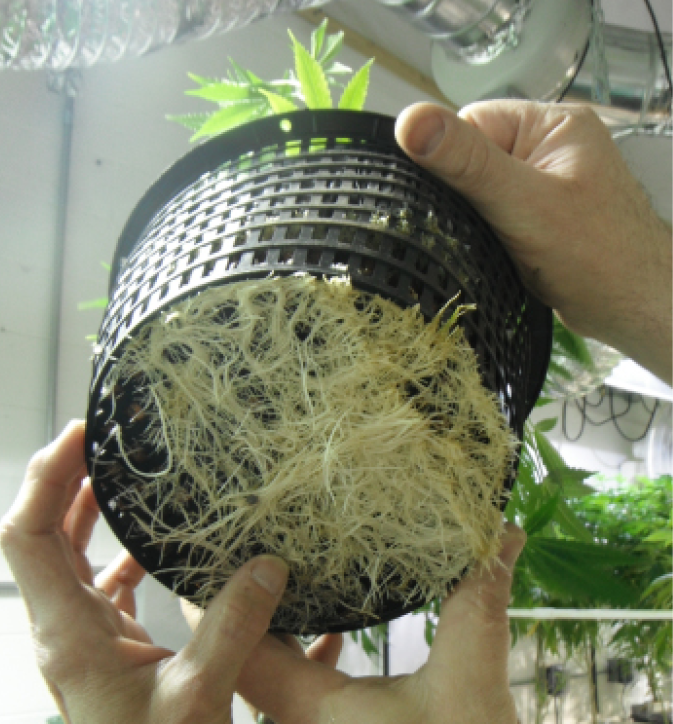
Hydroponic growing is ideal for revealing a plant’s true genetics, delivering high yields and quality, if you can deal with the pH roller coaster. (Fortunately, there are ways to do so.)
There are 17 mineral elements from the periodic chart recognized as essential to a plant’s completion of its life and reproductive cycle: Nitrogen, Phosphorus, Potassium, Calcium, Magnesium, Sulfur, Manganese, Iron, Boron, Molybdenum, Copper, Zinc, Chlorine and recently added Nickel. Give a plant enough of these along with CO2, water and light, and its DNA will deliver whatever it has locked inside. A good place to pick that lock is a hydroponic table.
Stripped Hydro
A breeder wants to see a strain’s inherent strengths and weaknesses. If plants are being driven hard by nutrients and numerous performance-enhancing supplements, the performance enhancers can make up for a plant’s weaknesses and could hide a weakness from the breeder. Stripping the nutrient scheme down allows growers to accurately assess plant character when looking for potential breeding stock.
Stripped hydro systems use rockwool or no-substrate techniques, water-soluble fertilizers (pre-mixed product lines or water-soluble salts) and atmospheric CO2 levels. There is little to add to or subtract from the plant’s DNA, and the plant’s strengths and weakness are easily assessed.
Hydro's reputation is that it delivers high yields and top quality, and is the cleanest way to grow in a pesticide-free/limited environment. Now that the grower has a baseline on the plant’s stripped performance, he can find optimized CO2 and nutrient levels. The recirculating/ebb-and-flow-system user can easily and accurately measure nutrient uptake, then associate uptake patterns to nutrients delivered to provide effective nutrient recipes, and predict plant size and yield based on nutrient delivery. These are valuable capabilities, and to get them, grower’s first need to address pH management.
The pH Roller Coaster
Hydro systems are known for dramatic pH shifts and swings, putting pH management first on the list when designing a hydro system. Get pH management right, and the rest is easy.
Stripped hydro has nothing in the system to resist pH change. Slight additions of an acid or base will change an ebb-and-flow reservoir’s pH readily. With nutrient-uptake efficiency closely tied to pH, growers want to keep pH close to a target level. (Growers decide at what pH level they get the best results. Typical pHs we see range from 5.8 to 7.0.) The challenge in doing that is addressing the underlying source of pH swings: plants’ nitrogen uptake and the resulting reaction.
Depending on which form of nitrogen a plant takes up, the plant exerts an acidic or basic influence on the root zone pH. When plants take up nitrogen ions, they expel other ions as a result of the plant’s biology, balancing itself as required by the laws of physics. H+ ions (Hydrogen) are released after NH4+ (ammonium) uptake, which lowers pH; and OH- ions are released after NO3- (nitrate) uptake, which raises pH.
The higher the uptake rate, the higher the rate of pH changes. Experienced hydro jockeys attest to how fast changes occur. This is true no matter what media is used, but the effect is pronounced in stripped hydro because of the lack of pH buffering.
Stop the Roller Coaster
So how does a grower stop the pH rollercoaster? The majority of pre-mixed nutrient products on the market deliver predominately nitrate nitrogen, which means that users of these products should expect root zone pH to rise in a hydro system. If pre-mixed nutrient products are used in a recirculating system with rockwool/no-substrate approaches, and the reservoir pH does not rise over time, the nutrient product likely contains a pH buffering agent. If that pH remains relatively steady over time, the nutrient product has a pH buffer in it that will hold the roller coaster at bay, and the grower is good to grow. If reservoir pH steadily rises, however, the nutrient product contains no buffering agents, and manual pH management is required.

Acid to the Rescue
The most common practice employed is the use of pH-adjusting products that chemically reduce or increase pH. With nitrate nitrogen-dominate nutrients, the hydroponic grower is looking for pH increases, so pH-down or acidifying products are called for.
In a recirculating hydro system, measurement of solution pH tells the grower how much the plants are raising the pH over time. To establish the proper counter measure to this increase, get a lab analysis of the solution’s alkalinity in parts per million (ppm). With that and knowing how much pH change is needed, growers can use the ALKCALC tool (http://bit.ly/ALKCALC) from the University of New Hampshire to compute exactly how much acid is required to bring the pH down to the target level. This sets the operational point for how much acid to add to the reservoir on an ongoing basis for any given point in the growing cycle. As uptake varies in plants throughout their lives, the resulting pH pressure also varies, so growers need to assess their acid-amendment volumes based on plant age and size, and use that information to link the acid-addition procedure to plant age.
Monitoring solution pH is key to management. Mainstream recirculating systems often measure pH of outbound and return solutions, showing how much the pH was affected by a pass through the plants. Measuring reservoir solution pH in ebb and flow systems before and after a flow cycle provides a similar view of the system’s rate of pH change.
Now With Bonus Nutrients!
Acid addition to hydro systems also delivers nutrients. When any acid (represented here as [H, A]) is added to a solution and dissolves, a hydrogen ion (“H+”) is released, increasing acidity and lowering pH. But at the same time, an ion of “A” is also released. With phosphoric acid, the “A's” are phosphate ions, sulfuric acid/sulfate ions and nitric Acid/nitrate ions. Because the pH adjustment also delivers nutrients, growers need to consider the type and volume of nutrients added. Again, the ALKCALC tool not only will tell a grower how much of any given acid is needed to change a solution’s pH, but also computes how many ppm of the nutrient “A” is being added, and growers can decide if they need or want to adjust their nutrient solution recipes.
Phosphoric and nitric acids can unbalance a nutrient scheme with frequent use, but sulfuric acid does not affect the key ratios and levels of nitrogen, phosphorus and potassium set by the nutrient-solutions recipe, nor does it have significant impact on the plant’s growth rate (also not true of nitrogen and phosphorus). Acid costs vary widely, with sulfuric and nitric acids being the cheapest.
Judo pH Management
While the acid-addition approach to pH management is the most common approach seen in mainstream hydroponics, users of dry salt-water-soluble fertilizers can use judo on their plants by turning the plant’s own actions against them. The pH in the root zone can be raised, lowered or held steady using specific mixtures of the two main nitrogen sources. Knowing that ammoniacal nitrogen drops pH three times faster than nitrate nitrogen raises it, the water-soluble grower can mix ammonium sulfate with calcium nitrate and/or potassium nitrate to achieve a 1:3 ratio of ammonium to nitrate nitrogen. As plants uptake these two nitrogen forms, the opposing pH pressures cancel each other out, resulting in low to no pressure on pH.
Changing the ratios produces variable amounts of pH pressure up or down depending on the mixture, but in a recirculating hydro system, the grower wants to target and hold the 1:3 ratio to “hold” the pH steady. Even with a “hold” nitrogen mixture, pH will vary within some range. If that variation is too great, acid can still be used to bring the pH down, and the amount of acid used will be less than if the nutrient recipe used only pH-raising nitrate nitrogen.
Combining the two nitrogen forms to get pH control also allows growers to leverage the fact that total nitrogen uptake has been enhanced when both ammoniacal and nitrate nitrogen forms are present.
Alternative Approaches
More complex solutions to pH management exist, such as making pH buffering solutions to add to hydro solutions. Some users with extreme pH situations may be faced with unique issues that warrant using resin ion exchange columns to reduce pH. While more complex than acid addition or nitrogen mixing, these approaches are quite effective and should be considered in cases where the other solutions do not work.
Onto the Merry Go Round
Once a grower has a pH management procedure, managing nutrient levels is more of a merry-go-round. With pre-mixed products, simply follow the manufacturer’s directions. With water-soluble nutrient salts, the equations that link grams of salt added to the resulting ppm of the constituent nutrients takes all of the mystery out of nutrient levels. Calculators also are available to take the math out of the mix.
If you love hydro, but hate dealing with pH problems, you are a few simple techniques away from stopping the pH roller coaster and opening the door to success.
Since our column in the March/April issue of Cannabis Business Times talked about flushing, it is worth noting that recirculating-system growers don’t replace their nutrient solutions in the last week with pure water, so hydro plants never get “flushed.”
You can learn more at Otokehort.com/nutrients_for_cannabis.



Explore the May 2016 Issue
Check out more from this issue and find you next story to read.
Latest from Cannabis Business Times
- Aurora Marks 1st Medical Cannabis Shipment to New Zealand Market
- Where All 100 US Senators Stand on SAFER Banking Act
- Blumenauer Unveils Legislative Blueprint, Additional Administrative Action Needed Following Rescheduling
- Cannabis Rescheduling FAQ: What Now?
- From Custodian to Cultivation Supervisor
- California City in Cannabis Retail Desert Welcomes 1st Dispensary
- US Senate Democrats Forgo Addressing Intoxicating Hemp in 2024 Farm Bill Summary
- Verano Opens 3rd Connecticut Social Equity Joint Venture Dispensary





